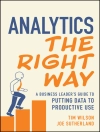A comprehensive, one-stop guide to identifying, reducing, and
managing nonresponse in household surveys
Nonresponse and its impact on the sample selection mechanism of
a survey is a common problem that often arises while collecting
survey data. Handbook of Nonresponse in Household Surveys is a
complete guide to handling the nonresponse problem, outlining
statistical methods and techniques for improving response rates and
correcting response data.
The authors begin with an introduction to the nonresponse
problem along with basic concepts and definitions. Subsequent
chapters present current theories and methods that enable survey
researchers to skillfully account for nonresponse in their
research. Exploring the latest developments in the field, the book
also features:
* An introduction to the R-indicator as an indicator of survey
quality
* Discussion of the different causes of nonresponse
* Extensive treatment of the selection and use of auxiliary
information
* Best practices for re-approaching nonrespondents
* An overview of advanced nonresponse correction techniques
* Coverage of adaptive survey design
Throughout the book, the treatment of each topic is presented in
a uniform fashion. Following an introduction, each chapter presents
the key theories and formulas underlying the topic and then
illustrates common applications. Discussion concludes with a
summary of the main concepts as well as a glossary of key terms and
a set of exercises that allows readers to test their comprehension
of the presented material. Examples using real survey data are
provided, and a related website features additional data sets,
which can be easily analyzed using Stata® or SPSS®
software.
Handbook of Nonresponse in Household Surveys is an essential
reference for survey researchers working in the fields of business,
economics, government, and the social sciences who gather, analyze,
and draw results from data. It is also a suitable supplement for
courses on survey methods at the upper-undergraduate and graduate
levels.
İçerik tablosu
Preface.
Chapter 1 The Nonresponse Problem.
1.1. Introduction.
1.2. Theory.
1.3. Application.
1.4. Summary.
1.5. Key Terms.
1.6. References.
1.7. Exercises.
Chapter 2 Basic Theoretical Concepts.
2.1. Introduction.
2.2. Theory.
2.3. Application.
2.4. Summary.
2.5. Key Terms.
2.6. References.
2.7. Exercises.
Chapter 3 Reducing Nonresponse.
3.1. Introduction.
3.2. Theory.
3.3. Application.
3.4. Summary.
3.5. Key Terms.
3.6. References.
3.7. Exercises.
Chapter 4 Nonresponse and the Mode of Data Collection.
4.1. Introduction.
4.2. Theory. 93
4.3. Application.
4.4. Summary.
4.5. Key Terms.
4.6. References.
4.7. Exercises.
Chapter 5 Analysis of Nonresponse.
5.1. Introduction.
5.2. Theory.
5.3. Application.
5.4. Summary.
5.5. Key Terms.
5.6. References.
5.7. Exercises.
Chapter 6 An International Comparison of Nonresponse.
6.1. Introduction.
6.2. Theory.
6.3. Application.
6.4. Summary.
6.5. Key Terms.
6.6. References.
6.7. Exercises.
Chapter 7 Nonresponse and Representativity.
7.1. Introduction.
7.2. Theory.
7.3. Application.
7.4. Summary.
7.5. Key Terms.
7.6. References.
7.7. Exercises.
Chapter 8 Weighting Adjustment Techniques.
8.1. Introduction.
8.2. Poststratification.
8.3. Linear Weighting.
8.4. Multiplicative Weighting.
8.5. Other Weighting Issues.
8.6. Summary.
8.7. Key Terms.
8.8. References.
8.9. Exercises.
Chapter 9 Selection of Auxiliary Variables.
9.1. Introduction.
9.2. Theory.
9.3. Application.
9.4. Summary.
9.5. Key Terms.
9.6. References.
9.7. Exercises.
Chapter 10 Re-approaching Nonrespondents.
10.1. Introduction.
10.2. Theory.
10.3. Application.
10.4. Summary.
10.5. Key Terms.
10.6. References.
10.7. Exercises.
Chapter 11 The Use of Response Propensities.
11.1. Introduction.
11.2. Theory.
11.3. Application.
11.4. Summary.
11.5. Key Terms.
11.6. References.
11.7. Exercises.
Chapter 12 Analysis and Adjustment Accounting for the Cause of
Nonresponse.
12.1. Introduction.
12.2. Theory.
12.3. Application.
12.4. Summary.
12.5. Key Terms.
12.6. References.
12.7. Exercises.
Chapter 13 Adaptive Survey Designs.
13.1. Introduction.
13.2. Theory.
13.3. Application.
13.4. Summary.
13.5. Key Terms.
13.6. References.
13.7. Exercises.
Chapter 14 Item Nonresponse.
14.1. Introduction.
14.2. Theory.
14.3. Application.
14.4. Summary.
14.5. Key Terms.
14.6. References.
14.7. Exercises.
Chapter 15 Miscellaneous Topics.
15.1. Introduction.
15.2. Theory.
15.3. Summary.
15.4. Key Terms.
15.5. References.
15.6. Exercises.
Index.
Yazar hakkında
Jelke Bethlehem, Ph D, is Senior Survey Methodologist in the
Division of Methodology and Quality at Statistics Netherlands and
Professor at the University of Amsterdam. His current research
interests include web surveys, computer-assisted survey information
collection, graphical techniques in statistics, and the development
of user-friendly software for statistical analysis. Dr. Bethlehem
is the author of Applied Survey Methods: A Statistical Perspective
and coeditor of Computer Assisted Survey Information Collection,
both published by Wiley.
Fannie Cobben, Ph D, is Project Manager at Statistics
Netherlands, focusing on the redesign of household surveys. She has
written several published papers on the topics of nonresponse,
representativity, and adjustment methods in survey research.
Barry Schouten, Ph D, is Senior Methodologist in the Division of
Methodology and Quality at Statistics Netherlands. Dr. Schouten’s
areas of research interest include nonresponse and response bias in
mixed-mode surveys, indicators for representativeness of response,
and adaptive and responsive survey designs.












